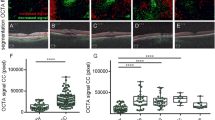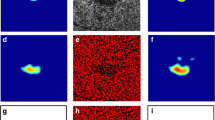Abstract
Purpose
To correlate choriocapillaris (CC) flow deficits (FD) in eyes with geographic atrophy (GA) at various distances from the border of the GA lesion with yearly enlargement rate (yER) of GA.
Methods
In this retrospective study, spectral domain optical coherence tomography (SD-OCT) and SD optical coherence tomography angiography (OCTA) images were collected from patients with GA, who were imaged at Doheny Eye Centers between 2016 and 2018, using the Cirrus HD-OCT (Carl Zeiss Meditec, Dublin, CA). All enrolled patients had one baseline 6 × 6 mm OCTA scan and two 6 × 6 mm SD-OCT cubes, one at baseline and one at a follow-up visit at least 12 months later. The border of the GA was manually outlined on the en face OCT fundus image and the yER was calculated after square root transformation. A grid composed of 100-μm-wide successive concentric rings was created around the GA lesion on the OCTA CC slab using ImageJ and the FD% was calculated from the binarized image. FD% from each ring was correlated with the yER of GA.
Results
Thirty eyes of 22 patients were included in the study. The mean yER was 0.2 ± 0.15 mm. The FD% in the first five rings (from 0 to 500 μm from the border of GA) was significantly correlated with the yER. However, there was no statistically significant correlation between the yER and CC FD% beyond 500 μm from the GA lesion.
Conclusions
Only the choriocapillaris FD% in the 500-μm region immediately surrounding GA lesions appears to predict the rate of enlargement of these lesions.






Similar content being viewed by others
References
Sadda SR, Guymer R, Holz FG et al (2018) Consensus definition for atrophy associated with age-related macular degeneration on OCT: classification of atrophy report 3. Ophthalmology 125:537–548
Schmitz-Valckenberg S, Sadda S, Staurenghi G et al (2016) Geographic atrophy: semantic considerations and literature review. Retina 36:2250–2264
Moreira-Neto CA, Moult EM, Fujimoto JG et al (2018) Choriocapillaris loss in advanced age-related macular degeneration. J Ophthalmol 2018:8125267
Sacconi R, Corbelli E, Carnevali A et al (2018) Optical coherence tomography angiography in geographic atrophy. Retina 38:2350–2355
Corbelli E, Sacconi R, Rabiolo A et al (2017) Optical coherence tomography angiography in the evaluation of geographic atrophy area extension. Invest Ophthalmol Vis Sci 58:5201–5208
Nassisi M, Shi Y, Fan W et al (2019) Choriocapillaris impairment around the atrophic lesions in patients with geographic atrophy: a swept-source optical coherence tomography angiography study. Br J Ophthalmol 103:911–917
Fleckenstein M, Mitchell P, Freund KB et al (2018) The progression of geographic atrophy secondary to age-related macular degeneration. Ophthalmology 125:369–390
Batioglu F, Gedik Oguz Y, Demirel S, Ozmert E (2014) Geographic atrophy progression in eyes with age-related macular degeneration: role of fundus autofluorescence patterns, fellow eye and baseline atrophy area. Ophthalmic Res 52:53–59
Sunness JS, Margalit E, Srikumaran D et al (2007) The long-term natural history of geographic atrophy from age-related macular degeneration: enlargement of atrophy and implications for interventional clinical trials. Ophthalmology 114:271–277
Waheed NK, Moult EM, Fujimoto JG, Rosenfeld PJ (2016) Optical coherence tomography angiography of dry age-related macular degeneration. Dev Ophthalmol 56:91–100
Nassisi M, Baghdasaryan E, Borrelli E et al (2019) Choriocapillaris flow impairment surrounding geographic atrophy correlates with disease progression. PLoS One 14:e0212563
Rosenfeld PJ, Durbin MK, Roisman L et al (2016) ZEISS Angioplex spectral domain optical coherence tomography angiography: technical aspects. Dev Ophthalmol 56:18–29
Spaide RF (2016) Choriocapillaris flow features follow a power law distribution: implications for characterization and mechanisms of disease progression. Am J Ophthalmol 170:58–67
Zhang Q, Zheng F, Motulsky EH et al (2018) A novel strategy for quantifying choriocapillaris flow voids using swept-source OCT angiography. Invest Ophthalmol Vis Sci 59:203–211
Schneider CA, Rasband WS, Eliceiri KW (2012) NIH image to ImageJ: 25 years of image analysis. Nat Methods 9:671–675
Bearelly S, Chau FY, Koreishi A et al (2009) Spectral domain optical coherence tomography imaging of geographic atrophy margins. Ophthalmology 116:1762–1769
Spaide RF (2018) Ising model of choriocapillaris flow. Retina 38:79–83
Uji A, Balasubramanian S, Lei J et al (2017) Choriocapillaris imaging using multiple en face optical coherence tomography angiography image averaging. JAMA Ophthalmol 135:1197–1204
Phansalkar N, More S, Sabale A, Joshi M (2011) Adaptive local thresholding for detection of nuclei in diversity stained cytology images. In: 2011 International Conference on Communications and Signal Processing, Calicut, pp 218–220
Feuer WJ, Yehoshua Z, Gregori G et al (2013) Square root transformation of geographic atrophy area measurements to eliminate dependence of growth rates on baseline lesion measurements: a reanalysis of age-related eye disease study report no. 26. JAMA Ophthalmol 131:110–111
Yehoshua Z, Rosenfeld PJ, Gregori G et al (2011) Progression of geographic atrophy in age-related macular degeneration imaged with spectral domain optical coherence tomography. Ophthalmology 118:679–686
Pfau M, Lindner M, Goerdt L et al (2019) Prognostic value of shape-descriptive factors for the progression of geographic atrophy secondary to age-related macular degeneration. Retina 39:1527–1540
Thulliez M, Zhang Q, Shi Y et al (2019) Correlations between choriocapillaris flow deficits around geographic atrophy and enlargement rates based on swept-source OCT imaging. Ophthalmol Retin 3:478–488
Monés J, Biarnés M (2018) The rate of progression of geographic atrophy decreases with increasing baseline lesion size even after the square root transformation. Transl Vis Sci Technol 7:40
Bhutto I, Lutty G (2012) Understanding age-related macular degeneration (AMD): relationships between the photoreceptor/retinal pigment epithelium/Bruch’s membrane/choriocapillaris complex. Mol Asp Med 33:295–317
McLeod DS, Grebe R, Bhutto I et al (2009) Relationship between RPE and choriocapillaris in age-related macular degeneration. Invest Ophthalmol Vis Sci 50:4982–4991
Biesemeier A, Taubitz T, Julien S et al (2014) Choriocapillaris breakdown precedes retinal degeneration in age-related macular degeneration. Neurobiol Aging 35:2562–2573
Borrelli E, Shi Y, Uji A et al (2018) Topographic analysis of the choriocapillaris in intermediate age-related macular degeneration. Am J Ophthalmol 196:34–43
Moult EM, Waheed NK, Novais EA et al (2016) Swept-source optical coherence tomography angiography reveals choriocapillaris alterations in eyes with nascent geographic atrophy and drusen-associated geographic atrophy. Retina 36(Suppl 1):S2–S11
Kvanta A, Casselholm de Salles M, Amren U, Bartuma H (2017) Optical coherence tomography angiography of the foveal microvasculature in geographic atrophy. Retina 37:936–942
Keenan TD, Agron E, Domalpally A et al (2018) Progression of geographic atrophy in age-related macular degeneration: AREDS2 Report Number 16. Ophthalmology 125:1913–1928
Zanzottera EC, Ach T, Huisingh C et al (2016) Visualizing retinal pigment epithelium phenotypes in the transition to geographic atrophy in age-related macular degeneration. Retina 36(Suppl 1):S12–S25
Li M, Huisingh C, Messinger J et al (2018) Histology of geographic atrophy secondary to age-related macular degeneration: a multilayer approach. Retina 38:1937–1953
Pfau M, Muller PL, von der Emde L et al (2018) Mesopic and dark-adapted two-color fundus-controlled perimetry in geographic atrophy secondary to age-related macular degeneration. Retina. https://doi.org/10.1097/IAE.0000000000002337
Yehoshua Z, de Amorim Garcia Filho CA, Nunes RP et al (2015) Comparison of geographic atrophy growth rates using different imaging modalities in the COMPLETE Study. Ophthalmic Surg Lasers Imaging Retin 46:413–422
Yehoshua Z, Garcia Filho CAA, Penha FM et al (2013) Comparison of geographic atrophy measurements from the OCT fundus image and the sub-RPE slab image. Ophthalmic Surg Lasers Imaging Retin 44:127–132
Schaal KB, Gregori G, Rosenfeld PJ (2017) En face optical coherence tomography imaging for the detection of nascent geographic atrophy. Am J Ophthalmol 174:145–154
Novais EA, Adhi M, Moult EM et al (2016) Choroidal neovascularization analyzed on ultrahigh-speed swept-source optical coherence tomography angiography compared to spectral-domain optical coherence tomography angiography. Am J Ophthalmol 164:80–88
Financial disclosures
A.R. Alagorie, none; M. Nassisi, none; A. Verma, , none; M. Nittala, none; G. Corradetti, none; S. Velaga, none; S.R. Sadda, Allergan (C), Amgen (C), Carl Zeiss Meditec (F), Centervue (C, F), Genentech/Roche (C), Heidelberg (C), Novartis (C), Nidek (F), Oxurion (C), Optos (C, F), Topcon (F).
Author information
Authors and Affiliations
Corresponding author
Ethics declarations
Ethical approval
All procedures performed in studies involving human participants were in accordance with the ethical standards of the institutional and/or national research committee and with the 1964 Helsinki declaration and its later amendments or comparable ethical standards.
Informed consent
Consent was waived by the IRB because of the retrospective nature of the study.
Additional information
Publisher’s note
Springer Nature remains neutral with regard to jurisdictional claims in published maps and institutional affiliations.
Rights and permissions
About this article
Cite this article
Alagorie, A.R., Nassisi, M., Verma, A. et al. Relationship between proximity of choriocapillaris flow deficits and enlargement rate of geographic atrophy. Graefes Arch Clin Exp Ophthalmol 258, 995–1003 (2020). https://doi.org/10.1007/s00417-020-04615-w
Received:
Revised:
Accepted:
Published:
Issue Date:
DOI: https://doi.org/10.1007/s00417-020-04615-w




